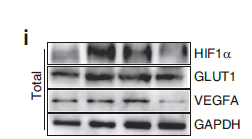
主要信息
Target
GluR-3
Host Species
Mouse
Reactivity
Human
Applications
WB, IHC, IF, ELISA
MW
101kD (Calculated)
Conjugate/Modification
Unmodified
货号: YM0309
规格
价格
货期
数量
200μL
¥5,880.00
一周
0
100μL
¥3,200.00
一周
0
50μL
¥2,000.00
一周
0
加入购物车


已收藏


收藏
详细信息
推荐稀释比
WB 1:500-1:2000; IHC 1:200-1:1000; ELISA 1:10000; IF 1:50-200
组成
Liquid in PBS containing 50% glycerol, 0.5% BSA and 0.02% sodium azide.
特异性
GluR-3 Monoclonal Antibody detects endogenous levels of GluR-3 protein.
纯化工艺
Affinity purification
储存
-15°C to -25°C/1 year(Do not lower than -25°C)
理论分子量
101kD
修饰
Unmodified
克隆性
Monoclonal
相关产品
抗原&靶点信息
免疫原:
Purified recombinant fragment of human GluR-3 expressed in E. Coli.
展开内容
特异性:
GluR-3 Monoclonal Antibody detects endogenous levels of GluR-3 protein.
展开内容
基因名称:
GRIA3
展开内容
蛋白名称:
Glutamate receptor 3
展开内容
别名:
GRIA3 ;
GLUR3 ;
GLURC ;
Glutamate receptor 3 ;
GluR-3 ;
AMPA-selective glutamate receptor 3 ;
GluR-C ;
GluR-K3 ;
Glutamate receptor ionotropic ;
AMPA 3 ;
GluA3
GLUR3 ;
GLURC ;
Glutamate receptor 3 ;
GluR-3 ;
AMPA-selective glutamate receptor 3 ;
GluR-C ;
GluR-K3 ;
Glutamate receptor ionotropic ;
AMPA 3 ;
GluA3
展开内容
背景:
Glutamate receptors are the predominant excitatory neurotransmitter receptors in the mammalian brain and are activated in a variety of normal neurophysiologic processes. These receptors are heteromeric protein complexes composed of multiple subunits, arranged to form ligand-gated ion channels. The classification of glutamate receptors is based on their activation by different pharmacologic agonists. The subunit encoded by this gene belongs to a family of AMPA (alpha-amino-3-hydroxy-5-methyl-4-isoxazole propionate)-sensitive glutamate receptors, and is subject to RNA editing (AGA->GGA; R->G). Alternative splicing at this locus results in different isoforms, which may vary in their signal transduction properties. [provided by RefSeq, Jul 2008],
展开内容
功能:
Caution:It is uncertain whether Met-1 or Met-7 is the initiator.,Disease:Defects in GRIA3 are the cause of mental retardation X-linked type 94 (MRX94) [MIM:300699]. Mental retardation is characterized by significantly sub-average general intellectual functioning associated with impairments in adaptative behavior and manifested during the developmental period. MRX94 patients have moderate mental retardation. Other variable features are macrocephaly, seizures, myoclonic jerks, autistic behavior, asthenic body habitus, distal muscle weakness and hyporeflexia.,Function:Ionotropic glutamate receptor. L-glutamate acts as an excitatory neurotransmitter at many synapses in the central nervous system. Binding of the excitatory neurotransmitter L-glutamate induces a conformation change, leading to the opening of the cation channel, and thereby converts the chemical signal to an electrical impulse. The receptor then desensitizes rapidly and enters a transient inactive state, characterized by the presence of bound agonist.,miscellaneous:The postsynaptic actions of Glu are mediated by a variety of receptors that are named according to their selective agonists. This receptor binds AMPA (quisqualate) > glutamate > kainate.,PTM:Palmitoylated. Depalmitoylated upon glutamate stimulation. Cys-621 palmitoylation leads to Golgi retention and decreased cell surface expression. In contrast, Cys-847 palmitoylation does not affect cell surface expression but regulates stimulation-dependent endocytosis.,similarity:Belongs to the glutamate-gated ion channel (TC 1.A.10) family.,subunit:Homotetramer or heterotetramer of pore-forming glutamate receptor subunits. Tetramers may be formed by the dimerization of dimers. Interacts with PRKCABP, GRIP1 and GRIP2.,
展开内容
细胞定位:
Cell membrane; Multi-pass membrane protein. Cell junction, synapse, postsynaptic cell membrane; Multi-pass membrane protein. Interaction with CNIH2 and CNIH3 promotes cell surface expression. .
展开内容
组织表达:
Brain,Hippocampus,Skin,
展开内容
研究领域:
>>cAMP signaling pathway ;
>>Neuroactive ligand-receptor interaction ;
>>Circadian entrainment ;
>>Retrograde endocannabinoid signaling ;
>>Glutamatergic synapse ;
>>Dopaminergic synapse ;
>>Long-term depression ;
>>Huntington disease ;
>>Spinocerebellar ataxia ;
>>Pathways of neurodegeneration - multiple diseases ;
>>Amphetamine addiction ;
>>Nicotine addiction ;
>>Transcriptional misregulation in cancer
>>Neuroactive ligand-receptor interaction ;
>>Circadian entrainment ;
>>Retrograde endocannabinoid signaling ;
>>Glutamatergic synapse ;
>>Dopaminergic synapse ;
>>Long-term depression ;
>>Huntington disease ;
>>Spinocerebellar ataxia ;
>>Pathways of neurodegeneration - multiple diseases ;
>>Amphetamine addiction ;
>>Nicotine addiction ;
>>Transcriptional misregulation in cancer
展开内容
信号通路
Organismal Systems >> Nervous system >> Glutamatergic synapse
Organismal Systems >> Nervous system >> Dopaminergic synapse
Human Diseases >> Cancer: overview >> Transcriptional misregulation in cancer
Human Diseases >> Neurodegenerative disease >> Huntington disease
Human Diseases >> Neurodegenerative disease >> Spinocerebellar ataxia
Human Diseases >> Neurodegenerative disease >> Pathways of neurodegeneration - multiple diseases
Environmental Information Processing >> Signal transduction >> cAMP signaling pathway
文献引用({{totalcount}})
货号: YM0309
规格
价格
货期
数量
200μL
¥5,880.00
一周
0
100μL
¥3,200.00
一周
0
50μL
¥2,000.00
一周
0
加入购物车


已收藏


收藏
Recently Viewed Products
Clear allToggle night Mode
{{pinfoXq.title || ''}}
Catalog: {{pinfoXq.catalog || ''}}
Filter:
All
{{item.name}}
{{pinfo.title}}
-{{pinfo.catalog}}
主要信息
Target
{{pinfo.target}}
Reactivity
{{pinfo.react}}
Applications
{{pinfo.applicat}}
Conjugate/Modification
{{pinfo.coupling}}/{{pinfo.modific}}
MW (kDa)
{{pinfo.mwcalc}}
Host Species
{{pinfo.hostspec}}
Isotype
{{pinfo.isotype}}
产品 {{index}}/{{pcount}}
上一个产品
下一个产品
{{pvTitle}}
滚轮缩放图片
{{pvDescr}}



















